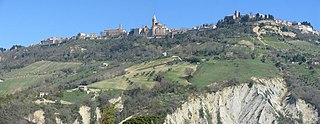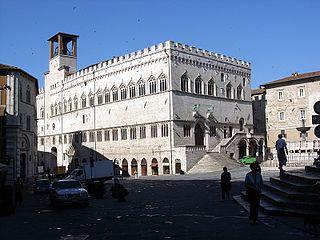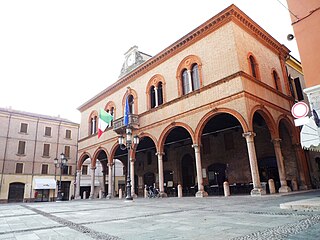History
The structure is formed by the fusion of two distinct buildings, the Palazzo del Comune with its ground floor arched portico built during the 12th to 14th centuries, and the Arringo built in the late 12th century. During the 15th century, both palaces were acquired by the Apostolic Camera, which converted this to the seat of the papal governor of the city, a function it served until 1564. In 1610 Giambattista Cavagna, architect of the Sanctuary of Loreto, refitted the buildings with a common façade, although the works started only in 1695 under a renewed design by Giuseppe Giosafatti, and was complete only in 1745.
The palace's façade was erected with travertine blocks, with a five-arcaded portico in the center supported by rusticated pilasters. The upper stories have idiosyncratic window frames. The first floor has alternating rounded and triangular window pediments supported by female caryatids, while the upper floor has male atlases supporting ionic capital volutes. The lower portal gives access to the 13th century main hall: this is a three-nave room with eight bays covered by cross-vaults, supported by cylindrical columns. It was known as fondachi, and was used by the Ascoli citizens as judiciary hall, market and storage hall.
The section of the former Palazzo Arringo contains the Pinacoteca Civica (Municipal Art Gallery). This portion of the building was refurbished in the 17th and 18th centuries. The gallery was instituted in 1861 after the suppression of the religious orders led to the central concentration of many works of art. [1] The palace of the commune currently houses the mayor's office.

Ascoli Piceno is a town and comune in the Marche region of Italy, capital of the province of the same name. Its population is around 46,000 but the urban area of the city has more than 93,000.

Piazza del Duomo is the main piazza of Milan, Italy. It is named after, and dominated by, Milan Cathedral. The piazza marks the center of the city, both in a geographic sense and because of its importance from an artistic, cultural, and social point of view. Rectangular in shape, with an overall area of 17,000 m2, the piazza includes some of the most important buildings of Milan, as well some of the most prestigious commercial activities, and it is by far the foremost tourist attraction of the city.

Piazza della Signoria is a w-shaped square in front of the Palazzo Vecchio in Florence, Italy. It was named after the Palazzo della Signoria, also called Palazzo Vecchio. It is the main point of the origin and history of the Florentine Republic and still maintains its reputation as the political focus of the city. It is the meeting place of Florentines as well as the numerous tourists, located near Palazzo Vecchio and Piazza del Duomo and gateway to Uffizi Gallery.

Offida is a comune (municipality) in the Province of Ascoli Piceno in the Italian region Marche, located about 80 km south of Ancona and about 12 km northeast of Ascoli Piceno, on a rocky spur between the valleys of the Tesino and Tronto (south) rivers.

Ripatransone is a comune (municipality) in the Province of Ascoli Piceno in the Italian region Marche, located about 70 kilometres (43 mi) southeast of Ancona and about 20 kilometres (12 mi) northeast of Ascoli Piceno.

Palazzo Madama e Casaforte degli Acaja is a palace in Turin, Piedmont. It was the first Senate of the Kingdom of Italy, and takes its traditional name from the embellishments it received under two queens (madama) of the House of Savoy.

Gallavresi Palace is a public building dating back, by all accounts, to the second half of the 13th century, which lies in the historical centre of the town of Caravaggio, in Lombardy, northern Italy; it has been see to the town administration since 1947.

The Palazzo dei Priori or comunale is one of the best examples in Italy of a public palace from the communal era. It is located in the central Piazza IV Novembre in Perugia, Umbria. It extends along Corso Vannucci up to Via Boncambi. It still houses part of the municipality, and, on the third floor, the Galleria Nazionale dell'Umbria. It takes its name from the Priori, the highest political authority governing the city in the medieval era.

The Palazzo del Podestà is a civic building in Bologna, northern Italy.

Palazzo d'Accursio is a palace once formulated to house major administrative offices of the city of Bologna, region of Emilia-Romagna, Italy. It is located on the Piazza Maggiore, and is the city's Town Hall. The palace is also home to the Civic Art Collection, with paintings from the Middle Ages to the 19th century; the Museo Morandi, with the works by Giorgio Morandi; and the Biblioteca Salaborsa, the town libraries.

The Praetorian Palace is a 15th-century Venetian Gothic palace in the city of Koper, in southwest Slovenia. Located on the southern side of the city's central Tito Square, it houses the Koper city government and a wedding hall. It is considered one of the city's architectural landmarks.

The Palazzo Comunale, also known as the Palazzo del Popolo of San Gimignano has been the seat of the civic authority in the comune since the 13th century. It is located on the Piazza del Duomo close to the Collegiate Church of the Assumption of the Blessed Virgin Mary. The building and Collegiate Church are at the heart of the medieval town, and are part of the UNESCO World Heritage Site of the "Historic Centre of San Gimignano".

Palazzo dei Consoli is a medieval building in Gubbio, Umbria, central Italy. It was built in 1332–1349 under design by Angelo da Orvieto, who is mentioned in the inscription on the portal.

Palazzo dei Convertendi is a reconstructed Renaissance palace in Rome. It originally faced the Piazza Scossacavalli, but was demolished and rebuilt along the north side of Via della Conciliazione, the wide avenue constructed between 1936 and 1950, which links St Peter's Basilica and the Vatican City to the centre of Rome. The palace is famous as the last home of the painter Raphael, who died there in 1520.

The Ventidio Basso Theater is the communal theater, concert hall, and opera house in the city of Ascoli Piceno region of Marche, Italy. It is located on via del Trivio, in front main cloister of the church of San Francesco, near piazza del Popolo. The exterior was erected in neoclassical-style, with grand interiors.

The Basilica di San Francesco is a Gothic-style, Roman Catholic church located on the Piazza del Popolo in the town of Ascoli Piceno in the region of Marche, Italy.

The Piazza Arringo, also known as the piazza dell'Arengo, is the oldest monumental piazza in the city of Ascoli Piceno.

The Ascoli Piceno Baptistery, also known as the baptistery of Saint John, is a religious building found on the eastern end of the piazza Arringo at the center of Ascoli Piceno and sitting next to and just north of the cathedral dedicated to St. Emygdius, the city's patron saint.

The Town hall of Mirandola is a historic public building located in the city center of Mirandola, in the province of Modena, Italy.

The Bergomi Palace is a 14th-century building in Mirandola, in the province of Modena, Italy.




















